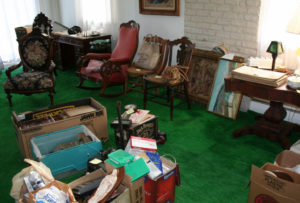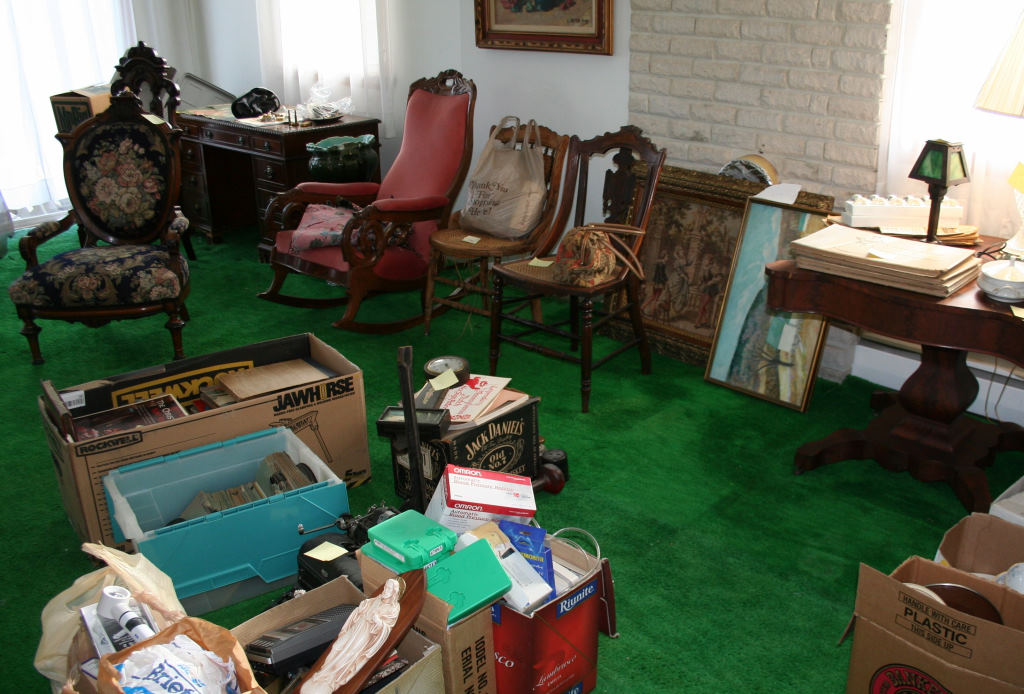
During all phases of our lives, we downsize. Early on downsizing might just be cleaning out your closet of old sneakers and boring toys as you heed your mother’s request. After college, downsizing might be getting rid of old sports equipment or notebooks. In your 30s on your career path, you downsize the clunky furniture your aunt gave you got your first apartment. By the time you are 50, downsizing includes boxes of unused stuff stored in your basement and donations to charities. After retirement, you beg your own kids to take their stuff so you can declutter and consider a move to a smaller home. Do you have stuff that you collected that you’d like to turn into cash? Most people do.
Your art, antiques, and collectibles should be considered in your long-term plan and even in your retirement plan. Why? Every now and then, it is a good idea to think about your collections in the long term rather than only in the short term. Retirement plans are all about value and collectibles are valuable. So, these go hand in hand. When I speak at national conferences to audiences of wealth managers and top financial advisors around the country, I tell them about how to help their clients turn collections into retirement cash.
Talk with your family members, financial advisors, and wealth managers about how your art, antiques, and collectibles fit into your future plans for generation wealth. Do you know that these assets such as Duncan Phyfe furniture, Staffordshire china, or Frederick Remington paintings should be part of your long-term retirement and estate plan? Make sure the antiques you’ve bought over the years help your family financially and end up supporting those you love, not some local dumpster diver that helps himself when you are downsizing. If you are just considering the idea of tossing everything into the trash and calling that process downsizing, think again. There is lots of cash in those unwanted collectibles.
Before you make decisions about financial matters, it is always wise to consult with a tax professional, financial advisor, or accountant. The information here should not be used in place of a consultation about your financial plan from one of those professionals.
1. Downsize like a Pro
Before you call in a team of muscle men with a truck and some fancy logo, listen to me … a true market insider. Around retirement age, people are anxious to downsize their big homes. They attempt to fit all their stuff into a small space and when they realize they can’t do it, they just give valuables away. Some will call in a junk-it outfit who move the stuff out and you will pay them to do what you can do for nothing. Before you know it, a lifetime of valuables–not just yours, but your mothers’ and grandmothers’ and sometimes even your kids stuff — has walked out the door with someone you paid to move it.
Once the truck leaves your house, they resell your stuff at auction or they resell it for pennies on the dollar to dealers, online, or elsewhere. You paid to buy it, you paid them to take it, and then you paid them again in the value of your items that they are reselling. Understandably, you may not have the time or energy to sell these items yourself but shouldn’t you get a piece of the action if you are giving your valuable away? Shouldn’t the moving fee be reduced or you get a percentage of what sold? Do you even know the current market for your collectibles?
2. Use Technology to Know what Gives
Downsize like a pro. How? Get a video chat appraisal with me of the items in your home before you downsize one item. Pick a date on your calendar, sign up to chat with me, take your smartphone, connect to Facetime, Zoom, Skype or whatever video chat you prefer and show me your stuff during a video chat by walking around your home, storage locker, garage, grandmothers’ house, etc. Move room to room and I will tell you what can go and what must stay, how to sell it, where to donate it, etc. I can appraise your stuff in real time and you can ask me questions on the spot.
For instance, recently I showed one family a 100,000 dollar painting that was hanging on the wall of their own house. Yes, during a video chat appraisal the family was shocked and they had no idea the little painting was valuable–really valuable. My client told me that her late mother had moved in with her and her husband and high school aged children for health reasons and that painting was given to her by an elderly aunt and her mother liked it so it was in the guest room where her mother lived until she passed. After mother passed, the painting continued to hang on the wall of her bedroom. During the video chat, the family was floored to learn what a secret that little painting held. I knew what it was, I recognized the 100,000 dollar value, I told them the truth unlike others in the same situation. Would you know how to spot a valuable? You have to know what you’ve got.
3. Monetize It
You can monetize your unwanted art, antiques, and collectibles by selling them using the many online selling tools. People are selling stuff and putting the extra money into savings accounts, college funds, retirement plans, etc. They are even engaging the help of their children and grandchildren who are very comfortable with how to use the internet to sell unwanted stuff. Young people know how to monetize objects and you have the objects to sell. Cutting out the middle men–auctioneers, dealers, resellers–and selling these items yourself with the aid of a tech-savvy child or grandchild will allow you to bring home a good amount of cash. There are so many ways to market and sell your unwanted collectibles. Click a photo, get an appraisal to show you the market data, use the appraisal description, make a listing to a collectibles-selling website or social media group and get it sold. Put the extra cash wherever you need it most. I outline in three easy steps how to sell your antiques.
For many people, donations are more difficult to understand than other aspect of collecting. According to the IRS, you may receive a tax deduction for a donated item’s full value up to 30% of your adjusted gross income. Yes, there is a right way and a wrong way to make a charitable donation. In order to command the biggest tax deduction for your donation, your donation must be for related-use. Huh? What’s that? Well, in layman’s terms … If you are gifting a work of art to a charity that is typically not in the art business then your donation may not be considered a related-use donation. You can’t get the full benefit for your donation if you donate your art incorrectly or to the “wrong” type of charity. On the other hand, if you donate your art to an organization that displays art on a regular basis like a museum, then that is considered a related-use donation and you can expect a higher tax deduction. Another option is to donate your art or collectibles to a charity in your will and have the full value used to reduce your estate taxes and reduce the burden on your children and grandchildren.
These assets–art, antiques, collectibles–which are considered valuables that are outside of a traditional portfolio of stocks, bonds, 401ks, and annuities are very valuable and should not be overlooked. When it doubt, ask your grandkids if they want something of yours. Why? Most people ask their children if that want the old clock, china service, or rocking chair but never think to ask a grandchild who may be thrilled to get that cookie jar or silver tray that you are ready to cast aside since their mother or father didn’t care for it. Grandchildren are almost always overlooked when it comes to collectibles and family heirlooms. You’d be surprised how many grandchildren want an heirloom from their grandparents like an old pocket watch, stuffed teddy bear, or china cup and saucer. Even people who don’t consider themselves collectors usually have a significant amount of money tied up in collectibles like vintage prints, china, crystal, sports collectibles, autographs, Hot Wheels toy cars and even Beanie Babies. Consider your valuable stuff and make sure you factor it into your plan to downsize and move along to the next phase of life.
Ask me, I’ll be happy to help.




